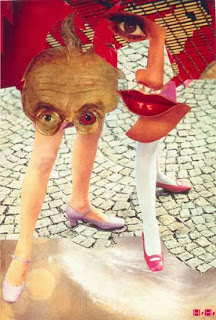One of my favorite art technique is photomontage. Until I read Meggs' History of Graphic Design, I didn't know that Dada artists claimed to have invented the photomontage technique such as shown in the picture of the poster made by Hannah Höch (p266 13-29). Here I'd like to introduce one of my favorite photographers called Jerry Uelsmann (http://www.uelsmann.net/). He is an American photographer know for the forerunner of photomontage and sort of a surrealist for his unique and unconventional designs in 20th century. All of his artworks are made in his black room, mounting several films together without using any digital tools we have today. I really like how he made his photographs by using traditional techniques just like people in that era was used to do.
Not only the artworks made by using techniques of photomontage but also collage, those artworks tend to be unique and transcended the common sense of pattern and form, thus viewers have to think carefully what are the messages that those artists are trying to deliver. This makes those designs impressive and the impact received by designs stuck in our head. Here is a quote from Jerry Uelsmann, saying "One of the major changes in attitude that occurred in the world of art as we moved from the nineteenth into the twentieth century was that the twentieth century artist became more involved with personal expression than with celebrating exclusively the values of the society or the church. Along with this change came a broader acceptance of the belief that the artist can invent a reality that is more meaningful than the one that is literally given to the eye." One thing I have noticed throughout reading these chapters is, like he said, artists tend to express more of their inside conflict, concerns, and opinions during the era of confusion by war.


No comments:
Post a Comment